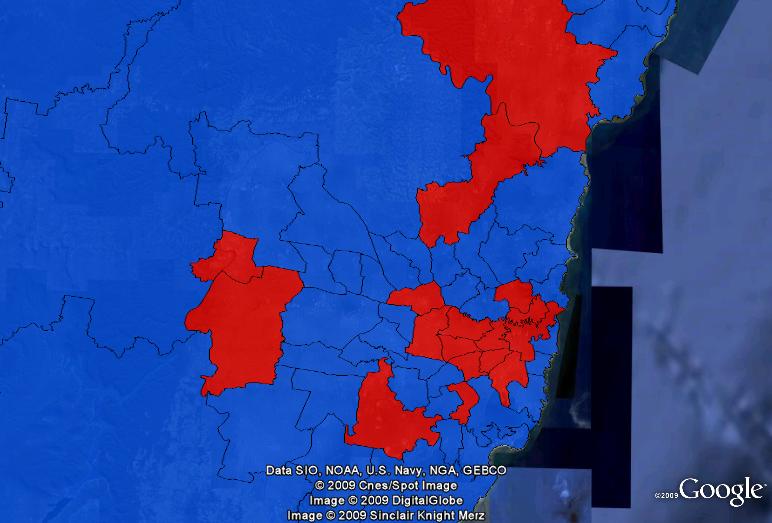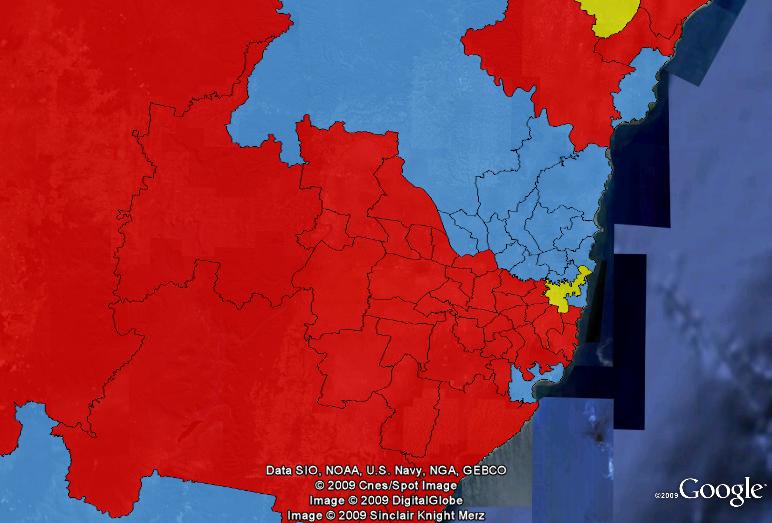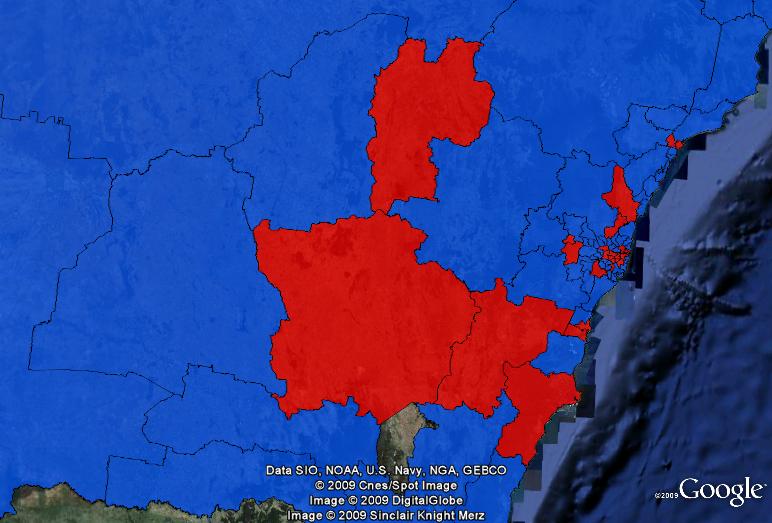I was looking the boundaries of the federal seat of Grayndler earlier today when I noticed that all five state electorates that overlap with Grayndler are held by female MPs, along with a number of other neighbouring seats. I thought it would be interesting to get an idea of how the gender balance in the Legislative Assembly is distributed geographically.
There are 25 women in the NSW Legislative Assembly, out of a total of 93 MLAs. Each party has the following gender balances:
- Labor – 17/51 – 33.3%
- Liberal – 5/23 – 21.7%
- National – 1/13 – 7.7%
- Independent – 2/6 – 33.3%

As you can see in Sydney, there is a large concentration of female MPs representing central Sydney. 11 out of 25 female MLAs hold seats in that contiguous area which stretches from Parramatta in the west to Willoughby in the north and Heffron in the south. One of these seats is held by independent Clover Moore, and the seats of North Shore and Willoughby are held by Liberals, while the other 8 are all Labor seats. In addition, there are two women Labor MPs in southern sydney, in Kogarah and Menai, and two more western Sydney seats in Penrith and Mulgoa.
There are also two more female MPs in the Greater Sydney region, one Liberal MP in Hornsby and a Labor MP in Gosford.

Let’s limit the analysis to the 35 Labor MPs in Sydney. Labor controls every seat in a region that covers a majority of the territory in Sydney, including everything south of the Harbour and the Hills district, with the exception of Vaucluse, Sydney and Cronulla. Excluding the Illawarra seats and Bathurst, which are part of the same contiguous block of Labor seats, there are 35 MPs in this area, making up two thirds of the Labor caucus and the base of their electoral support. In contrast, Labor holds less than one-third (16/58) of the seats outside of this zone. In Sydney, Labor has 12 female MPs and 23 male MPs, which is about the same proportion amongst the entire Labor caucus.
It gets interesting when you divide this area in half, into the 18 westernmost seats and the 17 easternmost seats. In the eastern area, that goes as far west as Auburn, Bankstown and Sutherland, there are actually a majority of women amongst Labor MPs with nine women amongst 17 MPs. Indeed, if you include non-Labor MPs in this area, you have an exactly even split of 10 men and 10 women, remarkable when you consider the overall proportion of women across the state.
When you leave Sydney, the proportions greatly fall, particularly in the north of the state. One of the four seats on the Central Coast is held by a woman. Out of the eight seats in the lower Hunter, two seats are held by women, both seats being in inner Newcastle. There are no women holding seats further north than Wallsend, just outside of Newcastle. The eight Nationals MPs in the area north of Newcastle are all male, as are the three independent MPs.

The seats south of Sydney have much higher representation by women. There are five Labor seats in the Illawarra area, a sixth Labor seat in Monaro and three Liberal seats to the south of Sydney. Out of these, there are two women in Wollongong and Shellharbour, and two women in Goulburn and South Coast. This produces a ratio of 4 women out of nine.
Western NSW is also strongly dominated by men. The two Liberal seats in southern NSW are both held by men, as is the sole Labor seat in Bathurst. There are five Nationals MPs in western NSW, one of whom is a woman. The sole independent MP in this region is also a woman (Dawn Fardell in Dubbo).



Has legislated compulsory affirmative action been considered for the NSW LC? What about for the Senate?
I’m pretty sure it hasn’t been considered. That’s a pretty radical step and could not get passed.
The NSW Legislative Council has a slightly higher proportion of women, mainly due to the Coalition parties, with 40% of Nationals MLCs and over 30% of Liberal MLCs.
If Labor and the Greens voted for it it would pass (unless a referendum is needed). It would increase the proportion of women to nearly 50% if compulsory alternation of candidate gender was introduced.
It’s not going to happen. It would absolutely need a referendum and would be a dramatic change.
It would not need a referendum for the senate though. Which part of the NSW constitution would make it need a referendum? It would be a big change. Of course I would prefer Tasmania/ACT style Hare-Clark where the voters would chose which of the candidates from a party would be elected but probably still with affirmative action quotas for candidates.
I’m not sure where you would need to change the constitution, but it would be a fairly dramatic change in the electoral system, either to mandate parties to run alternating male and female candidates, or to promote female candidates over men. Either way, it’s a hugely dramatic move. I doubt a single MP would support it to be used in general elections.
Having mandated quotas for the number of female MPs would also arguably send the wrong message and reinforce the sort of outdated thinking that it is designed to counter – implying that women aren’t able to get elected on their own merits.
If individual parties still have problems with cultural barriers preventing women from getting a fair go, then those parties could take steps internally to address this, such as implementing a policy like that themselves.
Personally I think this is something of a generational issue. It’s just never occurred to me to take gender into consideration when assessing the calibre of a politician, or deciding what I think of them. I assume this is because I’ve grown up in an era where women have held prominent positions – I can remember when Thatcher was in the dying days of her reign as British PM, when Carmen Lawrence and Joan Kirner became our first female Premiers, and Janine Haines, our first female leader of a national political party (well, only vaguely remember her and the 1990 election). Then there was that period after the 1993 election when Bronwyn Bishop was seriously being touted as a future PM. So I’m used to seeing women in power, and have just never thought of women as being any more or less capable than men – I’ve just never taken gender into account when considering whether I think a politician or candidate is good or bad.
Older people who remember a time when there were no women in prominent positions, and when old attitudes about women prevented them from getting recognised on their merits, would naturally see things differently.
Obviously there is still a problem with gender balance in politics, but I don’t think your approach Tom is either a necessary or desirable solution.
Nick, I think you are partly right in recognising that ultimately gender isn’t a barrier in the way it used to be. I would argue that, even though there are few positions a woman couldn’t rise to, there is still clear barriers to the same numbers of women.
The occasional outstanding figure like Julia Gillard or Anna Bligh can rise up through the ranks, but it still remains the case that there are a lot more mediocre men than women in Parliament.
Agreed, but I don’t like the idea of legislating to address that.
Neither do I. Although PR systems tend to vastly improve the representation of women and minorities.
There’s a very interesting academic paper (written by Deb Brennan from USyd) about women in the NSW Parliament called ‘Women in the Bear Pit’. Was presented at the APSA conference in Newcastle in 2006. Go to http://www.newcastle.edu.au/Resources/Schools/Newcastle%20Business%20School/APSA/ANZPOL/Brennan-Deborah.pdf
Meg
“The eight Nationals MPs in the area north of Newcastle are all male”
No surprises there. I could never fathom in my time in Nat Country how young women (among others) could justify voting National.
I’m more surprised that there’s a single female Nationals MP in Burrinjuck.
Katrina Hodgkinson might not have been married when you posted in July 2009, Ben, but she is now. She still goes by her maiden name though.
Comments are closed.